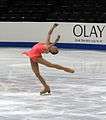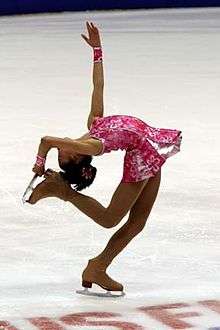Layback spin
| Figure skating element | |
|---|---|
.png) | |
| Element name: | Layback spin |
| Scoring abbreviation: | LSp |
| Element type: | Upright spin |
| Inventor: | Cecilia Colledge |
A layback spin is an upright figure skating spin in which the head and shoulders are dropped backwards and the back arched downwards toward the ice.[1] A common variation has the free leg lifted toward the back, typically in an attitude position, with the arms held above the body. A common, though very difficult, variation is the Biellmann spin.
History
The spin was invented by Cecilia Colledge of Great Britain.[2]
Technique

The iconic layback position is one in which the torso is bent backwards, the free leg lifted, and the arms extended above the torso, bent in an approximation of a circle. This creates a unique impression during the spin. This position has become iconic of figure skating, showing up in logos and banners promoting figure skating events, including the Olympic Games.
A layback spin can also be performed with the torso leaning more towards the side, in which case it is known as a side layback or sideways-leaning spin. Both backwards and sideways-leaning positions in a layback spin are considered a feature that adds difficulty under the ISU Judging System.
Variations
Other variations of the layback spin include ones where the free leg is gradually lowered so that it finally almost touches the ice. If it is performed in a manner that causes the spin to accelerate, it is considered a feature that adds difficulty. Various hand and arm positions are included to create individuality and artistry in the spin, including one and two-handed leg grabs, known to the judging panel as "haircutter" spins. The layback can also be performed to the side, which, if held long enough, can be considered a difficulty variation and adds to the level. Adding a Biellmann position to a layback spin is also considered a feature that adds difficulty. It is possible to perform a back layback spin and a change layback spin, however due to the difficulty both are rare.
Another variation is the flying layback, that is, a layback spin that is entered through a jump.[3] Differing techniques exist for the air position, but all require the skater to leap up into the air with an arch in the back and the free leg held to the side and the skating leg tucked like a flying sit. Since it is a same-foot flying spin, it requires fewer difficult features to attain a high level.
The flying layback spin is rarely performed because of the physical danger posed by landing with a hyperextended spine and the fact that few coaches know how the move is performed. However, some skaters such as Choi Ji Eun have been successfully credited with flying layback spins in competition.[4]
In competition
In competitive figure skating, the layback or sideways-leaning spin is a required element for ladies in the short program. Few male skaters perform this spin because it is not a required element at any level of men's competition. In addition, most males lack the back flexibility required by the position (a problem that is known to plague some female skaters as well). Male skaters to perform the layback in competition include Rohene Ward.
The spin is usually taught initially as the attitude spin, with only the leg behind in an attitude position. Once the skater can balance in that position, which is rather awkward at first, the skaters begin practicing the spin with an arch.
In the ISU Judging System, the layback spin is valued higher than other single position spins of the same nature (e.g. change of foot, flying entrance).[5]
Gallery
In single skating
 Attitude layback spin
Attitude layback spin
(Angela Nikodinov) Attitude layback spin (clockwise spinner)
Attitude layback spin (clockwise spinner)
(Alissa Czisny) Attitude layback spin
Attitude layback spin
(Rachael Flatt).jpg) Attitude layback spin
Attitude layback spin
(Mirai Nagasu) View from the front
View from the front
(Yukina Ota) View from the back (clockwise spinner)
View from the back (clockwise spinner)
(Ashley Wagner) View from the side
View from the side
(Kim Yuna) Sideways layback spin
Sideways layback spin A man performs layback spin
A man performs layback spin
(Rohene Ward) Catch-foot layback spin
Catch-foot layback spin
(Jelena Glebova) Catch-foot layback spin
Catch-foot layback spin
(Mirai Nagasu) Catch-foot "pearl" layback spin
Catch-foot "pearl" layback spin
(Caroline Zhang) Catch-foot layback spin
Catch-foot layback spin
(Alexandra Ievleva) Arm variation
Arm variation
(Elena Liashenko) Leg variation
Leg variation
(Fleur Maxwell) "Haircutter" variation
"Haircutter" variation
(Diane Szmiett) "Haircutter" variation
"Haircutter" variation
(Angela Maxwell)
In pairs

 Pair layback spin & sit spin
Pair layback spin & sit spin
(Sabine Baeß & Tassilo Thierbach)
References
| Wikimedia Commons has media related to Layback spins. |
- ↑ "USFSA: Glossary of Terms". Retrieved 2007-08-07.
- ↑ Petkevich, John Misha (1989). Figure Skating: Championship Techniques. Sports Illustrated. ISBN 1-56800-070-7.
- ↑ "ISU Communication No. 1445".
- ↑ ISU Junior Grand Prix SBC Cup Ladies Free Skating Protocol
- ↑ ISU Communication No. 1396